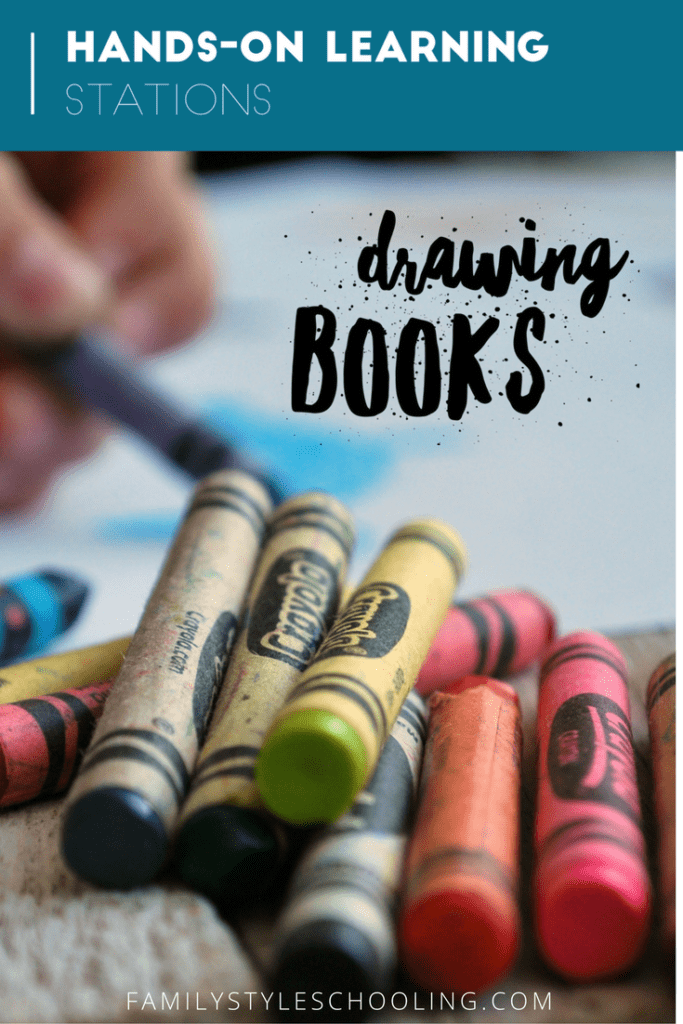Drawing Books: Hands-On Learning Stations
Drawing is not just about making beautiful works of art. Drawing cultivates observation, precision, fine-motor skills, patience, persistence, and a love for beauty to name a few. Frequently, kids can resist learning to draw because they believe they don't have any natural talent. Practice doesn't always make perfect, but it does make progress. That's what giving your child opportunities to practice drawing and resources like drawing books to learn with is all about.
I'm focusing on Art this week in my 31+ Days of Hands-On Learning Stations series, and today is all about learning to draw with drawing books.

The Best Drawing Books
- I Can Draw Animals - an Usborne book that my kids have used to draw with for years! They're such simple drawings that they're not intimidating to any artist. I Can Crayon is in the same family, and equally enjoyable.
- The Draw Write Now have also been one of our family's favorite drawing resources. There are so many animals, historical ideas, and geographical inspirations that fill the pages of these books that your kids can be inspired to draw for years with them. They also offer options for additional handwriting practice.
- For a little bit of a challenge, the Draw and Write Through History cover the same concept as the Draw Write Now books, but they offer more difficult drawings and cursive handwriting practice.
- A beautiful drawing book to incorporate into your US studies is the Learn to Draw American Landmarks and Heros book.

What if my kid doesn't like to draw?
You may find that your child doesn't like to draw because they are afraid of messing up or not drawing as well as their sibling. Here are some fun ways to adjust the assignment so that they can get practice without feeling so concerned with the finished product.
Adjust Writing Utensils
First of all, pencils are not very forgiving. Kids like to draw hard with pencils, there is no "draw lightly" in their bag of tricks. They appreciate the contrast of the dark lines. Unfortunately there is no eraser that can overcome that kind of pencil line. Once they start erasing, their artwork is never the same. Give them a different tool to draw with and see if they're more willing to practice drawing. Try these options:
- Draw on a mini dry erase board with a dry erase marker. These are much more forgiving.
- Try drawing on a boogie board. These don't erase easily, but they're not permanent, so that makes them less intimidating.
- Or make one of these fun printing bags. They could easily be used for simple drawings, and kids will love the sensory element to them.

Adjust the Scale of the Drawing
Sometimes the size of the paper can be a hindrance to reluctant artists. Some kids will appreciate if you make the paper smaller so they don't have so much space to fill, while others appreciate a bigger piece to draw on. Why not just give them some chalk and ask them to go tackle the driveway. If they end up creating something worth saving, snap a picture of it!

Adjust the Content of the Drawing
Even though it is great to connect your drawing practice to your history or science, sometimes it's good to just let them draw what they love. Connect their assignment to something that they're passionate about, and it will help them push beyond their normal limits.
What are some of your kids' favorite drawing instruction books?

Check out more hands-on learning stations inspiration in my 31+ Days of Hands-On Learning series! Looking for more art ideas? Try some of these:
Betsy Strauss is an unexpected homeschooler, mother of three, who is in a relationship with a sweet man for life. She loves reading books, drinking coffee, and learning anything with her kids.


